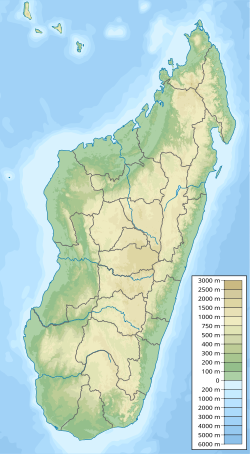| Berivotra Formation | |
|---|---|
| Stratigraphic range: Maastrichtian | |
 Masiakasaurus knopfleri theropod dinosaur | |
| Type | Geological formation |
| Underlies | Betsiboka Limestone |
| Overlies | Maevarano Formation |
| Lithology | |
| Primary | Siltstone, Marl |
| Location | |
| Coordinates | 15°54′S46°36′E / 15.9°S 46.6°E |
| Approximate paleocoordinates | 30°06′S38°24′E / 30.1°S 38.4°E |
| Region | Boeny, Mahajanga Province |
| Country | Madagascar |
| Extent | Mahajanga Basin |
| Type section | |
| Named for | Berivotra, Marovoay |
Location of the formation in Madagascar | |
The Berivotra Formation is a Maastrichtian sedimentary formation of the Mahajanga Basin in Boeny, Madagascar. It underlies the Danian Betsiboka Limestone, and is underlain (and partially coeval to) the Maevarano Formation. [1]
Contents
The tan and yellow claystones and marls of the formation were deposited along a shallow marine shelf that evolved slowly from a clastic-dominated to carbonate-dominated depositional environment. Whilst the fluvial sandstones of the Maevarano represent terrestrial, freshwater, and lacustrine environments, the Berivotra preserves the marine environment offshore, and many fossils of marine invertebrates (brachiopods, bryozoans, sea urchins, bivalves, and gastropods) are known. [1]
Many shark and ray teeth were collected by surface prospecting on outcrops of the Berivotra Formation, as have fossils of the frog Beelzebufo, which is also known from the Maevarano Formation. [2] Vertebral centra of bony fish are also known from the Berivotra. [1]
